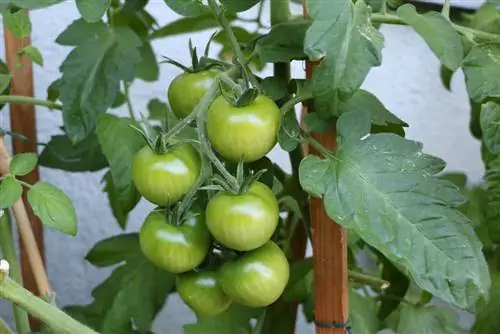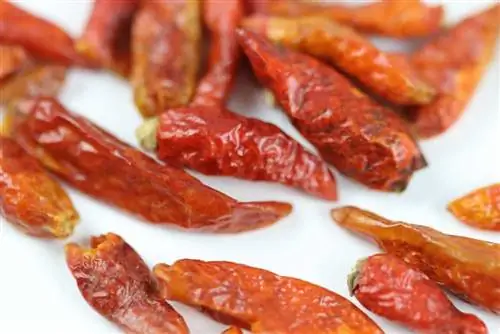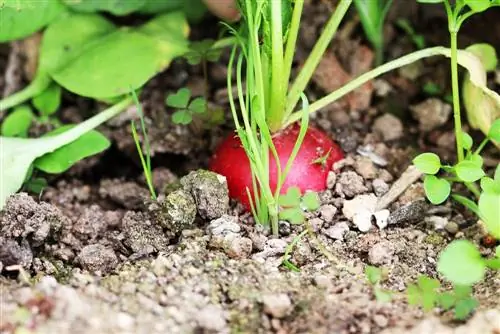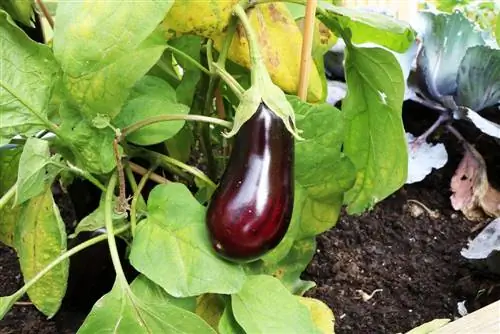- Author admin [email protected].
- Public 2023-12-17 03:39.
- Last modified 2025-01-24 12:45.
Tomatoes have been one of the most popular vegetables in local gardens for just over 100 years. Vitamin-rich tomatoes have become an indispensable part of the kitchen. Cultivating the tasty nightshade plants has long been a tradition for many hobby gardeners. There are well over 100 different varieties to choose from, which differ in taste, size and appearance. Sowing and growing tomato plants is simple and can be done quickly with the right tips.
The optimal time
The nightshade family originally comes from South America; the Portuguese and Spaniards brought the tasty fruits with them to Europe from their voyages of discovery. However, modern cultivated forms hardly have anything in common with the primitive and wild forms of the New World. The numerous varieties of Solanum sect. Lycopersicon differ not only in the size of the flowers and fruits, but also in their taste. However, nothing has changed in terms of care and location requirements. Under certain conditions, cultivation is also possible on the balcony or windowsill.
- A sunny, airy location is preferred
- Avoid drafts
- Protect from rain
- The substrate should be humus-rich and permeable
- A low lime content promotes the growth of perennials
- Fertilize regularly
In Mediterranean climates, tomato plants are perennial. In our latitudes, the intensely smelling plants are grown annually; the harvest begins in July and can last until the first frost. Even single-digit temperatures are extremely hard on sensitive South American plants. Direct sowing in the garden could only take place from mid-May when the risk of ground frost has been averted. Due to the growth and ripening time of exotic vegetable plants, this late date rarely leads to a successful harvest. Temperatures from 15° C are necessary for the popular plants to feel comfortable. To avoid this problem, you can grow the plants on the windowsill or in a warm greenhouse from the end of February.
Tip:
With a little time and research, it is possible to obtain seeds from heirloom tomato varieties. Horticultural associations and various internet forums are an ideal contact point for such inquiries.
Sowing behind glass
For experienced tomato gardeners, the season begins at the end of February and beginning of March. In order to give the young plants an optimal growth advantage, germination takes place in your own four walls or alternatively in the greenhouse. Whether aromatic cherry tomatoes or juicy beefsteak tomatoes, the varieties do not differ when sowing. The four factors heat, light, water and air play an important role in successful cultivation. The following materials are required for sowing tomato plants:
- Lean substrate
- Shallow cultivation container
- Water Atomizer

Choose the location wisely. Older specimens of Solanum sect. Lycopersicon need direct sunlight. UV radiation can have a negative effect on seeds or young seedlings. The substrate in the cultivation container dries out too quickly, and the small leaves are not yet able to adequately protect themselves from sunlight. Choose a bright spot for sowing, but protect the seedlings from the direct midday sun.
Tip:
Buy only tomato varieties that are resistant to brown blight and late blight.
Instructions for successful cultivation
Whether the nightshade seeds need to be watered before sowing divides passionate hobby gardeners into two camps. Many people swear that a water bath lasting several hours reduces the germination inhibition of the seeds. Other gardeners, on the other hand, plant the seeds without any further delay and can still enjoy a good germination rate. This measure does not harm the tomato seed, so you can try it yourself. To do this, place the fine seeds in lukewarm water for about 3 to 4 hours.
- Fill lean soil into the growing container
- Wet the substrate vigorously with a water sprayer
- Sowing seeds evenly
- A minimum distance of approximately 3 cm between the seeds is optimal
Solanum sect. Lycopersicon is a light germinator. For this reason, you should not cover the seeds with soil. Only press the fine grains lightly into the substrate. This will prevent wind and water from damaging the seeds. To protect the soil from cooling down, you should use a simple trick: place a thick Styrofoam plate under the container. This means the young seedlings don't get cold feet. Tomato seeds prefer to germinate at an ambient temperature of 20° to 24° C.
The nightshade family has an almost uncontrollable thirst. This begins with the cultivation of the young plants. The soil in the pot must not dry out. A watering can should not be used when re-watering. Spray the substrate regularly with a water sprayer. To avoid an unpleasant surprise, you should check the moisture content of the soil daily. As soon as the seedlings have a size of approximately 8 cm, you can take advantage of the capillary effect of the roots, in this case the water supply comes from below:
- Choose a shallow container with drainage holes for sowing
- Use a matching coaster
- Refill the water in the saucer regularly
- The water level should be approximately 2 cm high
- Waterlogging must not occur
Constant conditions

High humidity can hinder the germination of Solanum sect. Accelerate Lycopersicon. These conditions prevail, for example, in a greenhouse. Protected under glass, the young tomato plants thrive without being affected by ice and frost. You can also create a similar environment on your windowsill at home. The only materials you need are shish kebab sticks from the supermarket and a clear, perforated film.
- Place the wooden or plastic sticks on the edge of the growing container
- Moisten the substrate
- Tighten the perforated foil completely over the pot and the kebab skewers
To prevent mold and rot from forming in the soil, you should remove the film for a few hours every day. This promotes important air circulation. The improvised mini greenhouse has served its purpose as soon as the top leaves of the young tomato plants touch the film.
If the seedlings become long and spindly, there is usually a lack of light. In search of light, the plants grow rapidly and uncontrollably. The stems are then no longer able to support the entire weight of the plants. This is unhe althy and not very beneficial for the further development of the nightshade family. Move the seedlings to a cooler, bright location. If the light requirement at the window is not enough, you can use special lamps from garden shops.
Tip:
Avoid proximity to active radiators. Similar to direct sunlight, the substrate dries out too quickly.
Proper care
Under optimal conditions, the first green shoot tips of the nightshade family appear after about 2 to 3 weeks. From this point on you can literally watch the young plants grow. As soon as the plants have reached a height of around 8 to 10 cm, they must be pricked out. Take this measure in good time before the roots of the tomato plants grow together.
- Prepare small pots
- Use soil rich in humus
- Create a drainage made of porous material at the bottom of the bucket
Using a spoon, you can remove the seedlings from the old substrate and transfer them to the new container. Place the tomatoes in the substrate a few centimeters deeper than they previously grew. This prevents yellowing and promotes the formation of roots close to the surface. A final move into the garden is only possible from mid-May. Beforehand, slowly get the plants used to the outdoor weather.
Conclusion
Sowing and growing tomatoes is uncomplicated and can be done on the windowsill in spring without any major preparation. The demands of the nightshade family in terms of sunlight, nutrients, water and heat must be met so that passionate hobby gardeners receive a rich and tasty tomato harvest in summer.






